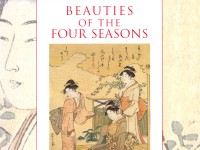Beauties of the Four Seasons
A full catalogue of the Ashmolean’s collection of Japanese bijinga (beautiful women) prints by Mitsuko Watanabe (published Oxford, 2005).

Publications online: 54 objects
- Reference URL
Actions
Part of...
Women by the Jewel River of Noji
-
Literature notes
Kubo shunman was a pupil of Kitao Shigemasa (1739-1820) and produced relaxed and elegant colour prints influenced by Kiyonaga. He was particularly adept at the use of muted colour schemes (benigirai) in the time when the government passed sumptuary regulations during the Tenmei and Kansei periods (1781-1800) forbidding the use of bright colours. 'The six jewel river' is one of the finest works by Shunman. The six rivers are all in different areas of Japan but Shunman’s six rivers from the Mutamagawa series is shown here as a continuous image. The collection of the Ashmolean Museum lacks the fifth image, that of Ogi of Shiga.
This print is Noji no Tamagawa (the Jewel River of Noji, also known as the Jewel River of Hagi). A standing beauty looks at her maid who is cutting a sprig from a hagi bush, while the other girl holds a lantern. In the sky, the moon appears among the clouds. This river is known for its clear water and the hagi that surround it, and many poems have been written about this river, associated with hagi. There is for example a famous poem by Minamoto no Toshiyori (c. 1055-1129), ('Let us come back tomorrow to the river of Noji. The waves which flow over the hagi branches beside the river bank reflect the moonlight'). -
Details
- Series
- The Six Jewel Rivers
- Associated place
- Date
- c. 1787 - 1788
- Artist/maker
-
Kubo Shunman (1757 - 1820) (designer)
- Associated people
-
Fushimiya Zenroku (active c. 1787 - 1792) (publisher)Daikandō (active 1740s - c. 1914) (publisher)
- Material and technique
- woodblock, printed with water-based vegetable pigments
- Dimensions
-
mount 55.7 x 24.4 cm (height x width)
print 37.6 x 24.4 cm (height x width)
- Material index
- Technique index
- Object type index
- No. of items
- 1
- Credit line
- Presented by Mrs Allan and Mr and Mrs H. N. Spalding, 1952.
- Accession no.
- EAX.4090.b
-
Further reading
Oxford: Ashmolean Museum, 24 August-30 November 2005, Beauties of the Four Seasons, Mitsuko Watanabe, ed. (Oxford: Ashmolean Museum, 2005), no. 23 on pp. 46-47, illus. pp. 48-49
Glossary
vegetable pigments
-
vegetable pigments
Vegetable pigments were used to create coloured dyes for Japanese prints, paintings, and textiles. These pigments often faded over time due to the chemical reactions they underwent.
Location
-
- currently in research collection
Objects are sometimes moved to a different location. Our object location data is usually updated on a monthly basis. Contact the Jameel Study Centre if you are planning to visit the museum to see a particular object on display, or would like to arrange an appointment to see an object in our reserve collections.
Publications online
-

Beauties of the Four Seasons
Kubo shunman was a pupil of Kitao Shigemasa (1739-1820) and produced relaxed and elegant colour prints influenced by Kiyonaga. He was particularly adept at the use of muted colour schemes (benigirai) in the time when the government passed sumptuary regulations during the Tenmei and Kansei periods (1781-1800) forbidding the use of bright colours. 'The six jewel river' is one of the finest works by Shunman. The six rivers are all in different areas of Japan but Shunman’s six rivers from the Mutamagawa series is shown here as a continuous image. The collection of the Ashmolean Museum lacks the fifth image, that of Ogi of Shiga.
This print is Noji no Tamagawa (the Jewel River of Noji, also known as the Jewel River of Hagi). A standing beauty looks at her maid who is cutting a sprig from a hagi bush, while the other girl holds a lantern. In the sky, the moon appears among the clouds. This river is known for its clear water and the hagi that surround it, and many poems have been written about this river, associated with hagi. There is for example a famous poem by Minamoto no Toshiyori (c. 1055-1129), ('Let us come back tomorrow to the river of Noji. The waves which flow over the hagi branches beside the river bank reflect the moonlight').
Notice
Object information may not accurately reflect the actual contents of the original publication, since our online objects contain current information held in our collections database. Click on 'buy this publication' to purchase printed versions of our online publications, where available, or contact the Jameel Study Centre to arrange access to books on our collections that are now out of print.
© 2013 University of Oxford - Ashmolean Museum


